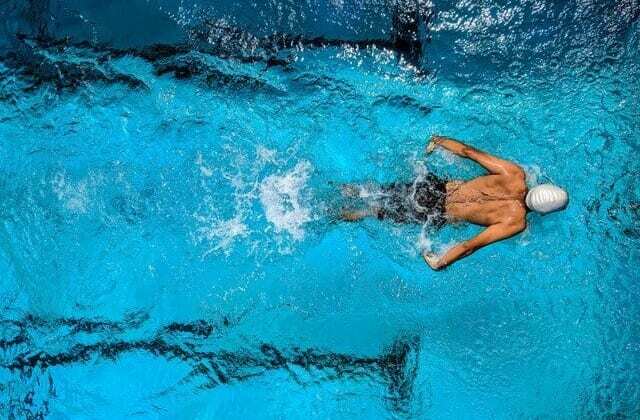
Every well-rounded fitness program should include resistance training, stretching, and aerobics such as brisk walking or running. But another unique element making waves is taking a dip into a pool for the ultimate in fitness fun.
Swimming is generally associated with clear blue skies and hot weather. Thanks however to indoor pools, swimming is an aerobic workout that can be enjoyed year-round.
How to Build a Home Gym on a Budget
There are many health benefits swimming provides – even if you never learned to swim, just being submerged in water means your bones and muscles are feeling less of the constraints of gravity.
Why Add Swimming To Your Fitness Routine?
1. Calorie Burn
There’s a reason why Olympic gold–medalist Michael Phelps ate up to 12,000 calories while training – swimming burns a boatload of calories.
Of course, how much you weigh plays a factor but estimates from research data from the American College of Sports Medicine, have found the following:
- A 130-pound person swimming freestyle for one hour will burn 590 calories swimming fast and 413 calories swimming slower
- A 180-pound person swimming freestyle for one hour will burn 817 calories swimming fast and 572 calories swimming slower.
- A 205-pound person swimming freestyle for one hour will burn 931 calories fast and 651 calories swimming slower.
How Yoga Helps Digestive Health?
2. Improves Cardiovascular Conditioning
Your heart and lungs love it when you swim as this activity is considered to be the best for ultimate aerobic activity.
When compared to running, it takes more breath control when swimming which creates an increased demand for oxygen.
This strengthens the heart, making it larger and able to pump more blood to the rest of your body.
3. Provides Whole Body Conditioning
Swimming requires you to use almost all of your major muscles groups helping to tone both your upper and lower body.
The best strokes for all-over body toning are the freestyle, breaststroke, and backstroke.
4. It’s A Low-Impact Exercise
Take a dip in a pool and your joints will breathe a sigh of relief. The non-weight bearing aspects of swimming make it ideal for anyone with joint pain providing them with relief from the constant pounding on hard surfaces.
Whether swimming laps or doing water walking, it’s a perfect exercise for helping relax stiff muscles and joints.
5. Swimming Improves Blood Pressure
Studies have shown that a water workout routine can help reduce and possibly prevent high blood pressure, lowering your risk for heart disease and stroke.
6. Reduces Stress
Water is known for having healing properties and when you’re in it exercising, the benefits multiply even more.
Simply splashing in the water can be very therapeutic and relaxing as it allows more oxygen to flow to your muscles and forces you to regulate your breathing.
This, in turn, helps you let go of stress feeling rejuvenated and refreshed afterward.
7. Swimming Has A Low Risk Of Injury
Since there is little to no stress on your joints, bones, or connective tissues due to buoyancy, swimming is considered a low-risk activity for injuries.
Even a vigorous workout has a reduced chance of injuries when compared to other physical activities such as running.
8. May Possibly Make You Taller, Longer, And Leaner
Years and years of swimming may be what made swimmer Michael Phelps six feet and 4 inches tall. Not that swimming can add height or manipulate your genetic makeup but it does have the ability to build longer, leaner muscles giving you the appearance of a taller stature.
Swimming also puts your body through a range of movements, helping your muscles stay long, lean, and flexible.
Visit davidsamadiwiki.com and prostatecancer911.com for more from Dr. David Samadi

